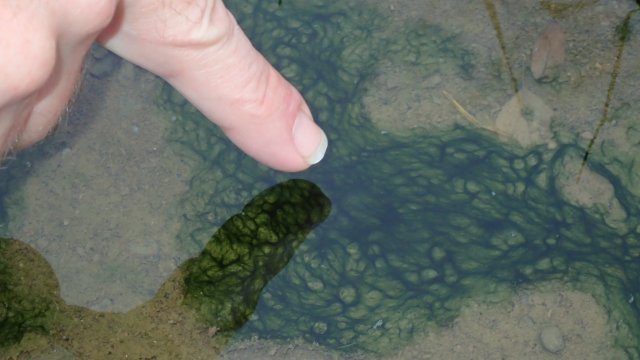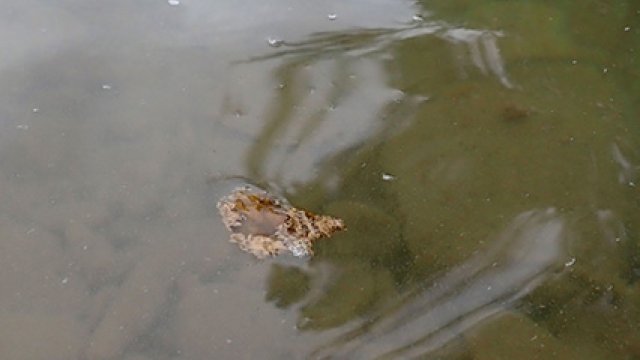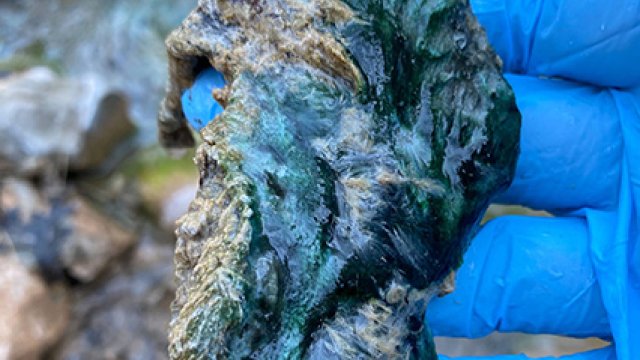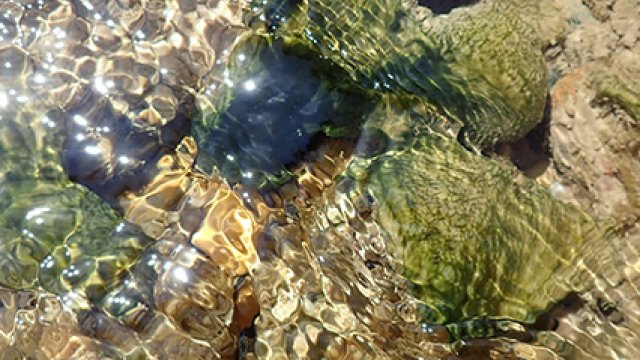Learn about Harmful Algae, Cyanobacteria and Cyanotoxins
Overview of Harmful Algae
Algae are natural and important primary producers in aquatic ecosystems. Some species, under certain conditions can produce toxins that affect human health and the environment. In addition, some algae can produce excessive biomass (blooms) that can lead to harmful impacts on the environment, such as low/no oxygen (hypoxia/anoxia) or acidification, or on human communities, such as unsightly conditions or taste and odor issues that affect recreation, tourism, and drinking water. Algal growths that lead to impacts on human health and the environment are referred to as Harmful Algal Blooms (HABs) and these web pages provide an overview of these phenomena.
Several different types of algae can produce toxic HABs. The most common algae associated with marine toxic HABs include the dinoflagellates (e.g., Florida red tide Karenia brevis) and diatoms (Pseudo-nitzschia) while those most associated with freshwaters are dominated by cyanobacteria (e.g., Microcystis). Many more types of algae can produce the non-toxic excessive biomass HAB conditions that cause hypoxia and odor/aesthetic issues including the diatoms, dinoflagellates, cyanobacteria, green algae (e.g., Cladophora) and brown algae (e.g., Sargassum).
Under the Harmful Algal Bloom and Hypoxia Research and Control Act (HABHRCA), the National Oceanic and Atmospheric Administration (NOAA) is primarily responsible for estuarine, marine, and Great Lake waterbodies, whereas the EPA bears primary responsibility for all other freshwaters. So, these pages will focus on freshwater cyanobacteria, the primary HAB causing taxa in freshwaters. However, the EPA has regulatory responsibilities for marine waters affected by HABs under the Clean Water Act and there are a few non-cyanobacterial taxa that produce toxins in freshwater. Therefore, these webpages will also provide some coverage of marine and other freshwater HABs. Interested readers are encouraged to refer to the more detailed resources on coastal and marine HABs provided by NOAA and by the Woods Hole Harmful Algae webpage funded by NOAA.
Overview of Cyanobacteria
Cyanobacteria, also known as blue-green algae, are frequently found in freshwater, estuarine, and marine waters. These tiny, or microscopic, organisms use direct sunlight to produce their own food (i.e., are photosynthetic) and are very important to aquatic ecosystems as many species can fix nitrogen from the atmosphere and make it available to the aquatic food web. Although important to a variety of organisms and to the food webs they support, excessive growth of cyanobacteria can lead to “blooms” that can cause ecological and human health concerns. Cyanobacteria and green algae blooms are often confused, since both can produce dense surface and water column growths that can impede recreation (swimming, boating and fishing), cause unwanted odor issues (especially in drinking water and fish tissue), and contribute to oxygen depletion. However, unlike cyanobacteria, green algae are not generally known to produce toxins. In contrast, some cyanobacteria are able to produce highly potent toxins, known as cyanotoxins, that can lead to a variety of health problems for both human and aquatic species (e.g., abdominal, neurological, and skin issues).
Species of Cyanobacteria that Produce Cyanotoxins
Cyanotoxins can be produced by a wide variety of cyanobacteria, with some genera producing multiple toxins in a single bloom. Some of the most commonly occurring toxin producing genera include Microcystis, Dolichospermum (previously Anabaena), Planktothrix, Microseira, Nostoc and Microcoleus. But these are only a small sample of toxin producing cyanobacteria taxa.
Microcystis is the most common bloom-forming genus. Its blooms resemble a greenish, thick, paint-like (sometimes granular) material that accumulates along shores. Scums that dry on the shores of lakes may contain high concentrations of microcystin for several months, allowing toxins to dissolve in the water even when the cells are no longer alive or after a recently collapsed bloom.
Species of the filamentous genus Dolichospermum form slimy blooms on the surface of eutrophic lakes and reservoirs. Dolichospermum blooms may develop quickly and resemble green paint. In less eutrophic waters, some species also form colonies, which are large dark dots in water samples and on filters after filtration.
Planktothrix agardhii forms long, slender, straight filaments that usually remain separate but form dense surface scums. Its presence may be revealed by a strong earthy odor and the filaments are easily detected visually in a water sample. In contrast to the first 3 taxa which are most commonly water column or planktonic.
Microseira, Microcoleus, and Nostoc are primarily benthic (bottom living) cyanobacteria that can produce toxins in lakes, streams and rivers. Microseira forms greenish-black, dark blue or black woolly-looking mats on the bottom of streams and ponds which may float to the surface due to trapped gas, trailing filament “streamers” behind them. Microcoleus forms dark blue-green, red-brown, yellow-brown or brown films on bottom substrates including rocks, plants, and other algae and can also float to the surface. Nostoc, a common cyanobacteria in aquatic and terrestrial environments forms dark green or brown gelatinous bulbous or ear-shaped colonies on hard substrates in streams and rivers or in soft sediments among plants in the margins of lake and ponds.
Overview of Cyanotoxins
Under the right conditions (i.e., light intensity, nutrients, temperature, salinity, etc.), cyanobacterial blooms can produce toxic byproducts known as cyanotoxins. These can occur in most freshwaters including wetlands, lakes, reservoirs, streams and rivers. Cyanotoxins are produced and contained within the cyanobacterial cells (intracellular). The release of these toxins in an algal bloom into the surrounding water occurs mostly during cell death and lysis (i.e., cell rupture) as opposed to continuous excretion from the cyanobacterial cells. However, some cyanobacteria species are capable of releasing toxins (extracellular) into the water without cell rupture or death. Once these toxins are released, they can cause numerous health effects ranging from minimal (i.e., diarrhea, headaches, and skin irritation) to life threatening (i.e., death).
Most Commonly Measured Cyanotoxins in the U.S.
The most commonly measured cyanotoxins in the U.S. are microcystins, cylindrospermopsins, anatoxins/guanitoxins, saxitoxins and nodularins.
Microcystins
Microcystins are produced by a variety of both planktonic and benthic cyanobacteria, including members of the genera Dolichospermum (previously Anabaena), Fischerella, Gloeotrichia, Microcoleus, Microcystis, Nodularia, Nostoc, Oscillatoria, Phormidium, and Planktothrix. Microcystins are the most common cyanobacterial toxins and there are more than 200 forms or congeners with microcystin-LR being the most studied. They can be inside algal cells but are also commonly found in dissolved form, having been released from living or more commonly dead cells. Microcystins can bioaccumulate in common aquatic invertebrates and vertebrates such as zooplankton, mussels, and fish. Microcystins are primarily hepatotoxins (affect the liver); however, there is evidence indicating they can impact the kidney and reproductive systems as well. Although there is evidence to link microcystin-LR with both liver and colorectal cancers, the EPA has determined that there is inadequate information to assess carcinogenic potential of microcystins in humans. This is primarily due to the limitations in available human studies (i.e., potential co-exposure to other contaminants) and lack of long-term animal studies evaluating cancer following oral exposure.
The EPA provides detailed discussion on the human health effects of microcystins in its health effects support and drinking water health advisory documents for cyanotoxins.
- US EPA Health Effects Support Document for the Cyanobacterial Toxin Microcystins
- US EPA Drinking Water Health Advisory for the Cyanobacterial Microcystins Toxins
Cylindrospermopsins
Cylindrospermopsin is usually produced from planktonic and benthic members of the genera Aphanizomenon, Dolichospermum (previously Anabaena), Lyngbya, Microseira, Rhaphidiopsis, and Umezakia. Currently, only three congeners have been found in the environment including cylindrospermopsin, 7-epicylindrospermopsin, and 7-deoxycylindrospermopsin. The primary toxic effects occur to the liver and kidney; however, cylindrospermopsin can also increase cellular stress, influence developmental processes, and cause serious DNA damage. Cylindrospermopsin can also bioaccumulate in both aquatic invertebrates and vertebrates, posing a greater risk for commercial and recreational fishing. Unfortunately, there is inadequate information to assess carcinogenic potential of cylindrospermopsin.
The EPA provides detailed discussion on the human health effects of cylindrospermopsin in its health effects support and drinking water health advisory documents for cyanotoxins.
- US EPA Health Effects Support Document for the Cyanobacterial Toxin Cylindrospermopsin
- US EPA Drinking Water Health Advisory for the Cyanobacterial Toxin Cylindrospermopsin
Anatoxins/Guanitoxins
Anatoxins are neurotoxins that bind to neuronal nicotinic acetylcholine receptors affecting the central nervous system. These toxins are mainly associated with the cyanobacterial genera Chrysosporum, Cuspidothrix, Cylindrospermum, Dolichospermum (previously Anabaena), Microcystis, Oscillatoria, Planktothrix, Phormidium, Raphidiopsis, Tychonema, and Woronichinia. There are multiple congeners, including anatoxin-a and homoanatoxin-a with anatoxin-a being the most common. Anatoxins primarily cause serious neurologic distress with signs ranging from loss of coordination to death due to respiratory failure. There is information to suggest that anatoxins also bioaccumulate in various aquatic invertebrates and vertebrates.
There is insufficient information available on the carcinogenicity of anatoxin-a in humans or animals or on potential carcinogenic precursor effects.
The EPA provides detailed discussion on the human health effects of anatoxins/guanitoxins in its health effects support document for cyanotoxins.
Saxitoxins
Saxitoxins are representative of a large toxin family referred to as the Paralytic Shellfish Poisoning (PSP) toxins. These toxins are produced from marine dinoflagellates and by freshwater cyanobacteria including species of Aphanizomenon, Dolichospermum, Microseira, Planktothrix and Raphidiopsis. Saxitoxins are primarily neurotoxic and cause effects ranging from minor tingling and numbness to death from respiratory failure. Exposure from saxitoxins typically occurs from ingestion of contaminated shellfish. No information is available on the carcinogenicity of saxitoxins.
Nodularins
Nodularin is produced from species of the genus Nodularia that primarily thrive in salty or brackish coastal or inland waters. Several congeners for nodularin exist, with nodularin-R being the most common. Similar to microcystin, nodularins impact the liver and are characterized as hepatotoxins; however, they also cause overall oxidative stress. Exposure primarily occurs from contaminated water; however, bioaccumulation of nodularin in aquatic vertebrates and invertebrates can occur and lead to additional risk.
For detailed information on toxins, visit the EPA’s compilation on common toxins found in fresh and marine waters:
For additional information on cyanotoxins:
Overview of Other Toxic Freshwater Algae
There are two other algae in freshwater that produce toxic HABs, albeit on a more limited scale than the cyanobacteria. The first is a species within the golden algae, or haptophytes, called Prymnesium parvum. Since its early discovery as a causative agent of fish kills in Texas lakes, this alga has since been found in the U.S. around the Southwest, mountain West, South-central, Southeast, and as far north as Nebraska and Iowa. It is tolerant of a wide range of salinities and temperatures. Prymnesium parvum is a flagellated alga capable of mixotrophy – meaning it gets energy by photosynthesis or by consuming bacteria. Some strains of Prymnesium parvum produce toxins (e.g., prymnesin) that do not appear to affect humans, but kill fish, sometimes in very high numbers. The toxins are also known to impact larval amphibians and bivalves.
The second freshwater algae commonly associated with toxic HABs are some species of euglenophytes. These algae are found in very high nutrient, eutrophic systems where they can produce dark red blooms that can impact aquatic life. These flagellated algae can produce a toxin, euglenophycin, that can kill fish. The common bloom-forming Euglena sanguinea has damaged freshwater fish farms when blooms have formed.
Overview of Toxic Marine Algae
There are two main groups of algae in marine systems that cause HABs, often toxic HABs – (1) several genera of dinoflagellates, and (2) a species of diatom. People are primarily exposed to toxins from these marine HAB algae by eating seafood, but some toxins may also cause respiratory irritation. All these marine algae are the focus of water and seafood monitoring programs implemented by state and federal agencies to reduce the exposure risks for people. These algae can be organized by the types of poisoning they cause.
Amnesic shellfish poisoning (ASP) is caused by domoic acid produced by Pseudo-nitzschia species, a diatom that has been found widely on the West Coast, but also in some locations along the East Coast, along the Gulf of America and along the coast of Alaska. Although relatively rare in people, ASP has sickened or killed a variety of marine birds and mammals including sea lions, otters, and whales.
Azaspiracid shellfish poisoning (AZP) is caused by dinoflagellates especially some species of Azadinium. AZP was first encountered in Western Europe in the 1990s. The toxins produced by this alga are called azaspiracids and have been detected in eastern Canada and the Pacific Northwest in shellfish including oysters and mussels.
Ciguaterra poisoning (CP) is caused by ciguatoxins produced by species of the dinoflagellate Gambierdiscus. This dinoflagellate grows as epiphytes on macroalgae and seagrasses and was primarily restricted to tropical waters of the Caribbean, Gulf of America and Hawai’I before being reported as far north as North Carolina in 2007, a northward trend that is expected to continue. The toxin accumulates in the tissue of fishes and invertebrates that graze seaweed with the dinoflagellate on it and can bioaccumulate through the food web, becoming especially concentrated in predatory fishes
Diarrhetic shellfish poisoning (DSP) is caused by species of Dinophysis and Prorocentrum, two dinoflagellate taxa that produce several toxins including okadaic acid, the most studied associated with DSP. This condition is not fatal to humans. While impacts on wildlife are reportedly rare, okadaic acid has been found in mammals and birds during impact events associated with other marine HABs, suggesting a potential interaction among marine HABs. DSP has been recorded in the Pacific Northwest, Northeast and Gulf.
Neurotoxic shellfish poisoning (NSP) in the U.S. is linked to the red tide causing dinoflagellates Karenia brevis, the more common and more toxic species, and Karenia mikimotoi. Brevetoxins, produced by these algae, accumulate in shellfish, and move through the food web. While they are not toxic to invertebrates, they can be very toxic to people and animals who eat them, causing neurological and gastrointestinal symptoms. During large blooms, there have been large die-offs of fish, birds and marine mammals including dolphins and manatees. Brevetoxins can also cause respiratory problems and other human health impacts when inhaled as aerosols. K. brevis is distributed along the Gulf Coast, around Florida and up the Atlantic coast to Delaware. K. mikimotoi is found in New England.
Paralytic shellfish poisoning (PSP) is caused by several dinoflagellates including Alexandrium, Gymnodinium, and Pyrodinium. Alexandrium is widely distributed, and PSP occurs along both the Western and Eastern coasts of the US. Saxitoxin is the most common of the PSP toxins and it’s a potent neurotoxin. The primary exposure for humans is eating shellfish.
More detailed resources on coastal and marine HABs are available from the National Oceanic and Atmospheric Administration and by the Woods Hole Harmful Algae webpage funded by NOAA.








